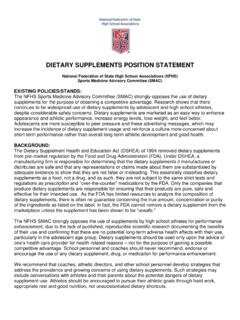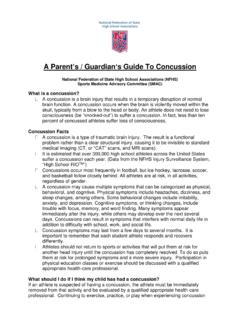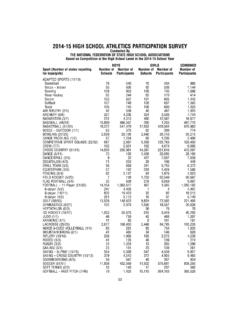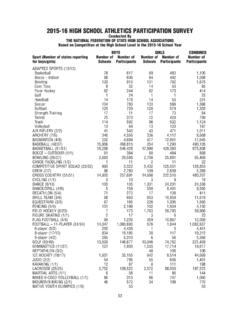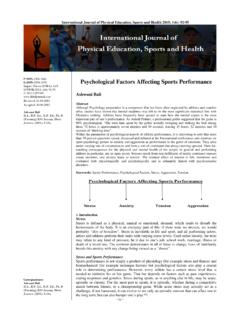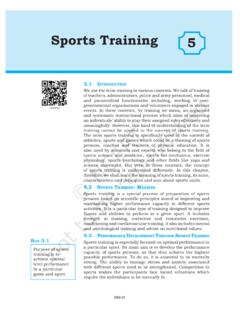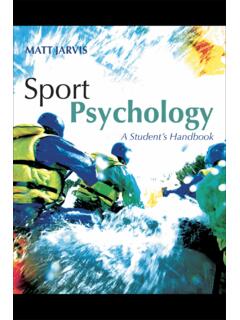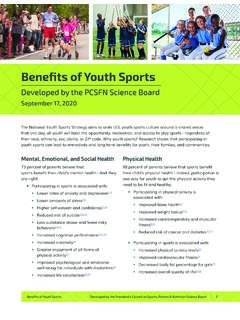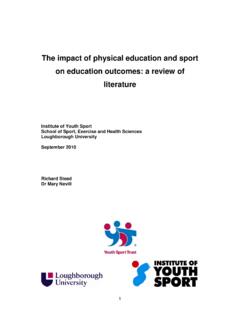Transcription of Mental Health in the High School Athlete - NFHS
1 Mental Health in the High School AthleteDr. Angela D. PellantMDBoard Certified Family and Sports MedicineJuly 1st, 2016 Goals and Objectives Understand and recognize the prevalence of Mental Health issues in student athletes Be familiar with the risk and protective factors for suicide Identify possible triggering events Be familiar with depression and its links to overtraining and concussion Recognize various presentations of anxiety Become familiar with ADHD, eating disorders, and bullying Develop a care team and treatment plan for Mental Health disorders and emergencies Understand legal and educational components of Mental Health issuesDefinitions and Statistics DSM Vdefines Mental disorder as: a clinically significant disturbance in cognition, emotional regulation, or behavior that reflects a dysfunction in the psychological, biological, or developmental process underlying Mental functioning Over 30% of adolescents meet criteria for anxiety disorder 20% have behavior disorders 14% experience mood disorders (twice as many girls as boys) 11% have substance-use disorders Prevalence increases with age; two fold increase in these disorders between age 13-14 and 17-18 Background Information Student athletes often define themselves by their identities as athletes.
2 Factors such as injuries, conflicts with coaches and teammates, and changes in interest level in their sport can increase the risk of Mental Health issues or worsen an already present concern. Identification of these risk factors or triggers and implementation of a care plan is key to caring for a student athletes Mental Events Certain events may trigger a new Mental Health concern or exacerbate an existing condition. Family or relationship issues Lack of playing time Violence-assault, domestic violence Death of friend or family Maladaptation to School issues Changes in interest in sport (burnout) Lack of sleep Substance abuseSuicide is the 3rdleading cause of death among 15-24 year 4700 young adults between the ages of 14-24 die by suicide annually in the US 1 in 6 high School students consider suicide 1 in 13 high School students attempt suicide one or more times Firearms are the most common method of death by suicide.
3 Suffocation, and poisoning are next most common. For every woman who dies by suicide, 4 men die by suicide. Women are 3 times more likely to attempt suicideRisk and Protective FactorsRisk FactorsProtective Factors Family history of suicide History of Mental disorders (depression, substance abuse) Feeling hopeless Cultural or religious beliefs Barriers to accessing Mental Health Unwillingness to seek help (stigma attached to Mental Health ) Physical illness Access to lethal methods Effective clinical care for Mental , physical, and substance abuse Family and community support Skills in problem solving, conflict resolution, and non-violent ways of handling disputes Cultural and religious beliefsSuicide Warning SignsStudent Athletes and Depression Participation in a team sport and Athlete identity are associated with lower depression scores. Moderate exercise is associated with reduced depression*Participation in 3 or more team sports and/or investing 7 or more hours per week to sport did not have the same benefits as moderate exercise.
4 Some increased scores for depression and anxiety *Signs and Symptoms of DepressionOvertraining and Depression Overtraining-cumulative training that results in LONG TERM decrease in sport specific performance with disturbances in mood. It may take weeks or months to recover. Exclude other possible causes of symptoms Infection Nutrition SleepOvertraining and Depression Much more common in high School athletes due to sports specialization and year round training. Mood changes can occur in as few as two days with high intensity training. How do we identify those at risk????*Sport specific questionnaires*Mood assessment daily*Psychomotor speed testsReduce the risk of Overtraining Adequate passive rest and SLEEP! Parent involvement Coach and medical staff education At least one rest day a week 7-9 hours of sleep nightly Good nutrition Well-rounded meals/snacks Plenty of protein Healthy carbsStudent Athletes and anxiety 85% of ATCs indicate that anxiety affects their student athletes.
5 anxiety may present as physical symptoms: rapid heart rate, feeling weak or dizzy, feeling like something is wrong Pressure from coaches, teachers, parents and peers are the most common reasons teens list as causes of their Those student athletes that have an underlying Mental Health issue will likely have a longer post-concussive recovery. Acute post-concussive mood changes may also predict a longer recovery. Many athletes may not have a Mental Health diagnosis but will have positive screening questionnaires when they are completed pre and post Changes and ConcussionSubstance and Alcohol Abuse 86% of high School students have seen a classmate drink, smoke, or use drugs during the School day. Having an untreated Mental illness will increase the likelihood of substance or alcohol use Opioid abuse is an epidemic and is becoming rampant in many high Hyperactivity DisorderEating Disorders/BullyingEating disordersBullying or Hazing Focusing on weight management can become obsessive and result in an eating disorder Monitor for: Intense fear of gaining weight Compulsive exercising Distorted body image Chronic sore throat/swollen glands (purging) An observed or perceived power imbalance For athletes this may present as: loss of focus, playing tentatively, anxiety , dropping out Hazing is just as prevalent in high School sports as in college sports.
6 (22%). Increased fighting, difficulty sleeping, eating, concentratingTeam Approach Coaches, team physician, ATCs, School nurse, School counselor, community Mental Health providers, crisis counselors Monitor Behaviors: Changes in eating and sleeping Wt. loss or gain Withdrawal Decreased interest in activities Difficulty concentrating Mood swings Excessive worry or agitation Negative self talk Increased physical complaintsThe Plan Establish the need for a plan regarding Mental Health issues in the student Athlete . Draft the plan Intro, education on Mental Health , behaviors to monitor, needs of student athletes, School district policy on referral, identify resources, discuss confidentiality Share the plan with School nurse, counselor, administration Once approved, distribute the plan to all sports medicine staff, physicians, School nurses, counselors, coaches, administrators. Review and update the plan annually or as neededMental Health Emergency Action Plan Respond with empathy and support Enact the School crisis response plan Ensure the safety of the student in crisis and others Collaborate with the Health care team Connect immediately with the needed resources Mobilize the student s support system Follow-up with the referralsMental Health History and the PPE Complete a basic screening questionnaire on the history portion of the PPE I often have trouble sleeping I wish I had more energy most days of the week I think about things over and over I feel anxious and nervous most of the time I often feel sad or depressed I struggle with being confident I don t feel hopeful about the future I have a hard time managing my emotions I have feelings of hurting myself or othersQuestionnairesLegal Issues State laws may vary in regards to reporting threats or emergencies.
7 Threat assessment a significant risk constitutes a high probability of substantial harm, not just a slight increase, speculative, or remote risk to the Health or safety of the student or others Policies in place in regards to release of confidential informationEducation and Recognition Provide education on stress/ stress management and available services. Educational component on psychological Health should be developed for presentation to student-athletes, coaches, and parents. Creating an environment in which student athletes feel safe discussing Mental Health . Formulate a plan to recognize and refer student athletes with psychological concerns. Ideally the ATC would be the point person in developing a plan Distribute the plan to School nurse, administrators, and community providers. Have regular educational sessions for coaches, staff and students regarding Mental Health issues and update the plan as Research Identification of Mental Health issues in high School and collegic athletes is a top priority for the NCAA and nfhs .
8 There are numerous research projects that are ongoing and are focusing on: Specific risk factors Screening questionnaires Preventative resources Treatment algorithmsConclusions The most important factors in helping student athletes with a Mental Health concern are: Education, early recognition, effective referral Understanding the stressors placed on student athletes as well as possible co-morbid illnesses will help identify Mental Health issues in this population. Developing a plan to address Mental Health issues and emergencies will make recognition and referral more effective and will minimize InterassociationRecommendations for Developing a Plan to Recognize and Refer Student-Athletes With Psychological Concerns at the Secondary School Level: A Consensus Statement Journal of Athletic Training 2015;50(3) 231-249. InterassociationRecommendations for Developing a Plan to Recognize and Refer Student-Athletes With Psychological Concerns at the Collegiate Level: An Executive Summary of a Consensus Statement.
9 Journal of Athletic Training2013;48(5):716-720 Lifetime Prevalence of Mental Disorders in US Adolescents: Resuultsfrom the National Comorbidity Study-Adolescent Supplement (NCS-A). J A AcadChild October;49(10) 980-989. Mental Well-Being and Sport Related Identieisin College Students. SociolSport Jule1;26(2):335-356 Prevention, Diagnosis, and Treatment of the Overtraining Syndrome: Joint Consensus Statement of the European College of Sport Science and the American College of Sports Medicine. 2012 ACSM. Preinjury somatization symptoms contribute to clinical recovery after sport-related concussion. American Academy of Neurology. 2012 Questions??????
